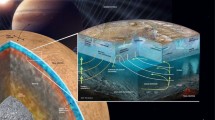Abstract
Ground-based spectroscopy of Jupiter's moon Europa, combined with gravity data, suggests that the satellite has an icy crust roughly 150 km thick and a rocky interior1,2,3,4. In addition, images obtained by the Voyager spacecraft revealed that Europa's surface is crossed by numerous intersecting ridges and dark bands (called lineae) and is sparsely cratered, indicating that the terrain is probably significantly younger than that of Ganymede and Callisto5. It has been suggested that Europa's thin outer ice shell might be separated from the moon's silicate interior by a liquid water layer, delayed or prevented from freezing by tidal heating6,7,8,9,10; in this model, the lineae could be explained by repetitive tidal deformation of the outer ice shell11,12,13. However, observational confirmation of a subsurface ocean was largely frustrated by the low resolution (>2 km per pixel) of the Voyager images14. Here we present high-resolution (54 m per pixel) Galileo spacecraft images of Europa, in which we find evidence for mobile ‘icebergs’. The detailed morphology of the terrain strongly supports the presence of liquid water at shallow depths below the surface, either today or at some time in the past. Moreover, lower-resolution observations of much larger regions suggest that the phenomena reported here are widespread.



Similar content being viewed by others
References
Kuiper, G. P. Planets and Satellites (Univ. Chicago Press, 1961).
Moroz, V. I. Infrared spectrophotometry of the Moon and the Galiliean satellites of Jupiter. Sov. Astron. A. J. 9, 999–1006.
Morrison, D. & Cruikshank, D. P. Physical properties of the natural satellites. Space Sci. Rev. 15, 641–739 (1974).
Anderson, J. D., Lau, E. L., Sjogren, W. L., Schubert, G. & Moore, W. B. Europa's differentiated internal structure: Inferences from two Galileo encounters. Science 276, 1236–1239 (1997).
Smith, B. A.et al. The Galilean satellites and Jupiter: Voyager 2 imaging science results. Science 206, 927–950 (1979).
Cassen, P., Reynolds, R. T. & Peale, S. J. Is there liquid water on Europa? Geophys. Res. Lett. 6, 731–734 (1979).
Cassen, P., Reynolds, R. T. & Peale, S. J. Tidal dissipation on Europa: A correction. Geophys. Res. Lett. 7, 987–989 (1980).
Squyres, S. W., Reynolds, R. T., Cassen, P. & Peale, S. J. Liquid water and active resurfacing on Europa. Nature 301, 225–226 (1983).
Ross, M. & Schubert, G. Tidal heating in an internal ocean model of Europa. Nature 325, 13–134 (1986).
Ojakangas, G. W. & Stevenson, D. J. Thermal state of an ice shell on Europa. Icarus 81, 220–241 (1989).
Greenberg, R. & Wiedenschillling, S. J. How fast do Galilean satellites spin? Icarus 58, 186–196 (1984).
Helfenstein, P. & Parmentier, E. M. Patterns of fractures and tidal stresses due to non-synchronous rotation: Implications for Europa. Icarus 612, 175–184 (1985).
McEwen, A. S. Tidal reorientation and the fracturing of Jupiter's moon Europa. Nature 321, 49–51 (1986).
Pappalardo, R. T., Head, J. W., Greeley, R. & the Galileo Imaging Team. AEuropa ocean? The (circumstantial) geological evidence. in Proc. Europa Ocean Conf. 59–60 (1996).
Lucchitta, B. L. & Soderblom, L. A. in Satellites of Jupiter (ed. Morrison, D.) 521–555 (Univ. Arizona Press, Tucson, 1982).
Pappalardo, R. T. & Coon, M. D. Asea analog for the surface of Europa. Lunar Planet. Sci. Conf. XXVII, 997–998 (1996).
Greeley, R.et al. Europa: Initial Galileo geological observations.(submitted).
Pappalardo, R. T.et al. Geological evidence for solid-state convection in Europa's ice shell. Nature 391, 365–368 (1998).
Schenk, P. M. & McKinnon, W. B. Fault offsets and lateral crustal movement on Europa: Evidence for a mobile ice shell. Icarus 79, 75–100 (1989).
Pappalardo, R. T. & Sullivan, R. J. Evidence for separation across a gray band on Europa. Icarus 123, 557–567 (1996).
Sullivan, R. & the Galileo Imaging Team. Galileo views of crustal disruption on Europa. Lunar Planet. Sci. Conf. XXVIII, 1395–1396 (1997).
Tufts, R. B., Greenberg, R., Sullivan, R., Pappalardo, R. & the Galileo Imaging Team. Lunar Planet Sci. Conf. XXVIII, 1455–1456 (1997).
Shoemaker, E. M. The age of Europa's surface.in Proc. Europa Ocean Conf. 65–66 (1996).
Chapman, C. R. & the Galileo Imaging Team. Populations of small craters on Europa, GanymedeandCallisto:InitialGalileoimagingresutls. Lunar Planet. Sci. Conf. XXVIII, 217–218 (1997).
Author information
Authors and Affiliations
Corresponding author
Rights and permissions
About this article
Cite this article
Carr, M., Belton, M., Chapman, C. et al. Evidence for a subsurface ocean on Europa. Nature 391, 363–365 (1998). https://doi.org/10.1038/34857
Received:
Accepted:
Issue Date:
DOI: https://doi.org/10.1038/34857
- Springer Nature Limited
This article is cited by
-
Planned Geological Investigations of the Europa Clipper Mission
Space Science Reviews (2024)
-
Battery-free wireless imaging of underwater environments
Nature Communications (2022)
-
Dynamic Europa ocean shows transient Taylor columns and convection driven by ice melting and salinity
Nature Communications (2021)
-
Organic Matter in the Solar System—Implications for Future on-Site and Sample Return Missions
Space Science Reviews (2020)
-
Ice-Ocean Exchange Processes in the Jovian and Saturnian Satellites
Space Science Reviews (2020)





